Individual Differences in Human Functioning
- Books Name
- Psychology Book Class-12
- Publication
- PathSet Publications
- Course
- CBSE Class 12
- Subject
- Psychology
Individual Differences in Human Functioning
- Each one of us is unique as we exemplify a typical combination of various traits i.e. different traits exist in an individual in varying degrees or intensities.
- Individual Differences refers to distinctiveness and variations among people's characteristics and behaviour patterns.
- Situationism states that situations and circumstances in which one is placed influence one's behaviour.
- Sometimes, the situational influences are so powerful that individuals with differing personality traits respond to them in almost the same ways. The situationist perspective views human behaviour relatively more as a result of influence of external factors
Assessment of Psychological Attributes
- Books Name
- Psychology Book Class-12
- Publication
- PathSet Publications
- Course
- CBSE Class 12
- Subject
- Psychology
Assessment of Psychological Attributes
- It is the first step in understanding a psychological attribute.
- It refers to the measurement of psychological attributes of individuals and their evaluation, often using multiple methods in terms of certain standards of comparison.
- Psychological assessment uses systematic testing procedures to evaluate abilities, behaviours, and personal qualities of individuals.
- There are two types of Assessment:
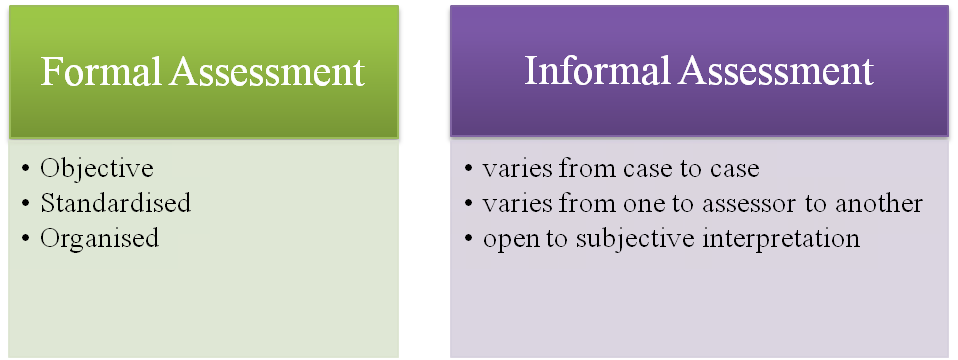
Characteristics of Psychological Attributes
- Complex in nature
- Multi-dimensional (Cognitive, Emotional, Social, etc.)
Psychological Attributes
Intelligence
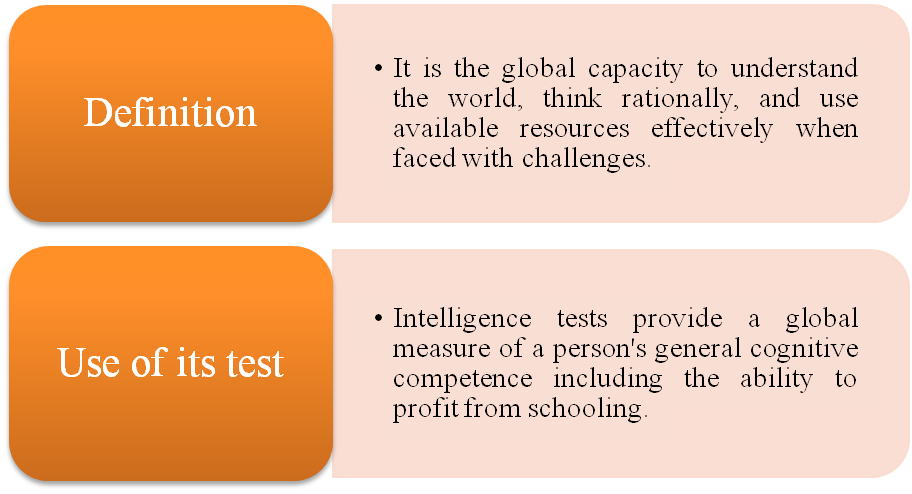
Aptitude
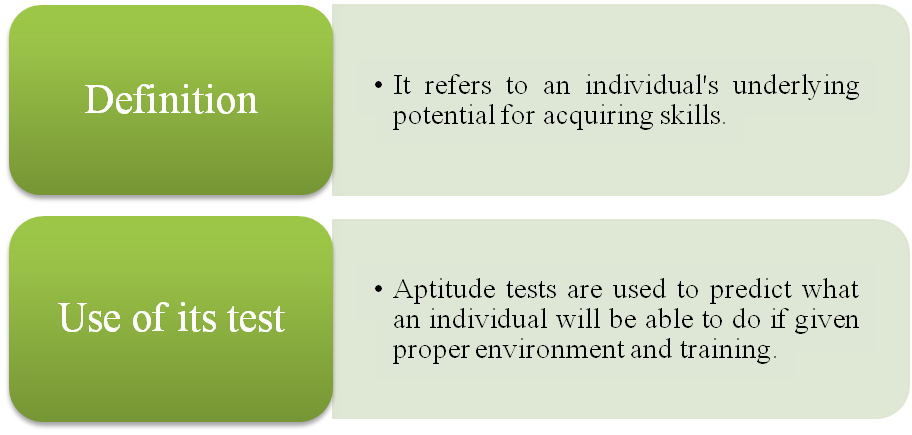
Interest
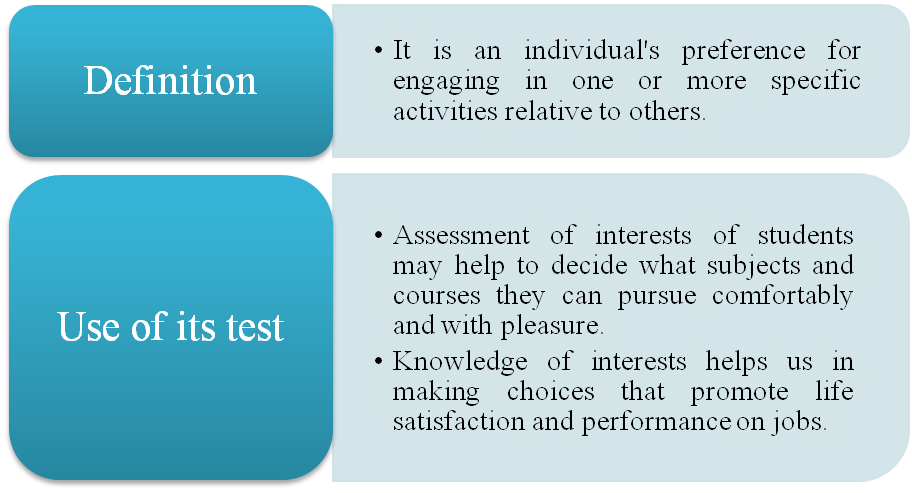
Personality
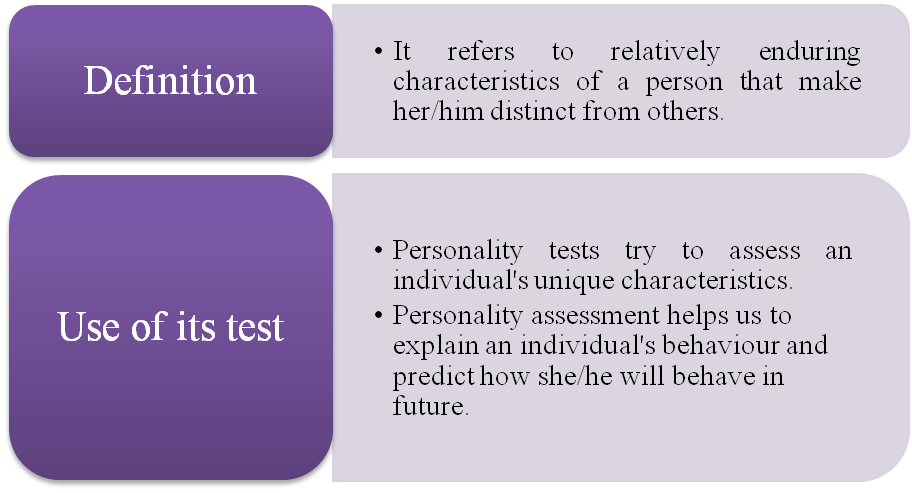
Values
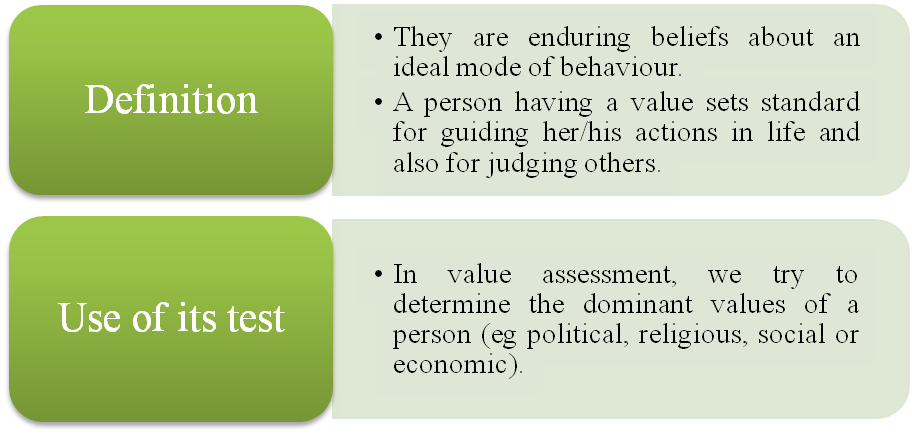
Assessment Methods
Psychological Test
- It is an objective and standardised measure of an individual's mental and/or behavioural characteristics.
- They are used for:
- Clinical diagnosis
- Guidance
- Personnel selection
- Placement
- Training
Interview
- It involves seeking information from a person on a one-to-one basis.
- It is used when:
- Counsellor interacts with a client -Salesperson makes a door-to-door survey
- Employer selects employees
Case Study
- It is an in-depth study of the individual in terms of her/his psychological attributes, psychological history in the context of her/his psychosocial and physical environment.
- It is used by clinical pcychologists.
Observation
- It involves employing systematic, organised, and objective procedures to record behavioural phenomena occuring naturally in real time.
Self Report
- It is a method in which a person provides factual information about herself / himself and/or opinions, beliefs, etc. that she/he holds.
- Such information may be obtained by using an interview schedule or a questionnaire, a psychological test or a personal diary.
Intelligence and Theories of Intelligence
- Books Name
- Psychology Book Class-12
- Publication
- PathSet Publications
- Course
- CBSE Class 12
- Subject
- Psychology
Definitions of Intelligence
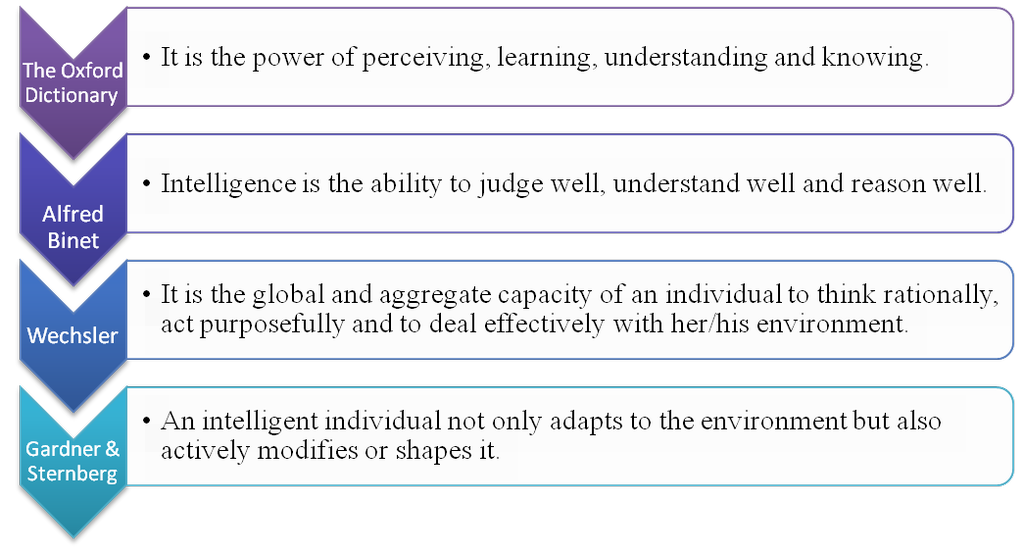
Theories of Intelligence
There are two approaches to theories of intelligence:
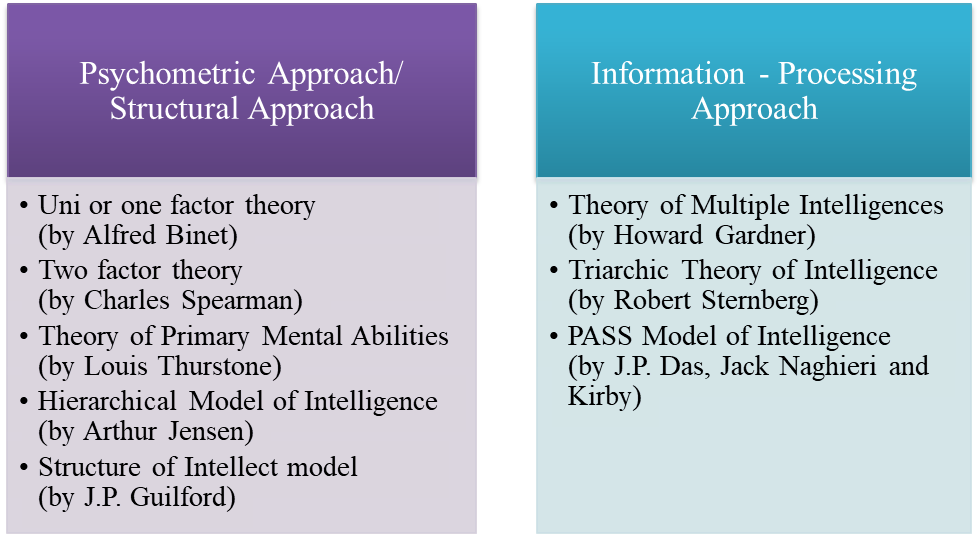
Psychometric approach/ Structural approach
- considers intelligence as an aggregate of abilities
- expresses the individual's performance in terms of a single index of cognitive abilities
A. Uni or one factor theory (by Alfred Binet)
According to him, intelligence consists of one similar set of abilities which can be used for solving any or every problem in an individual's environment.
B. Two factor theory (by Charles Spearman)
According to him, intelligence consists of:
i. General factor (g-factor) which includes mental operations which are primary and common to all performances.
ii. Specific factors (s-factors) which contains specific abilities which allow individuals to excel in their respective domains / fields. For eg, singing, dancing, cooking etc.
C. Theory of Primary Mental Abilities (by Louis Thurstone)
It states that intelligence consists of 7 primary abilities, independent of each other:
i. Verbal Comprehension - grasping meaning of words, concepts and ideas
ii. Numerical Abilities - speed and accuracy in numerical and computational skills
iii. Spacial Relations - visualising patterns and forms
iv. Perceptual speed - speed in perceiving details
v. Word Fluency - using words fluently and flexibly
vi. Memory - accuracy in recalling information
vii. Inductive Reasoning - deriving general rules from presented facts
D. Hierarchical Model of Intelligence (by Arthur Jensen)
This model consists of abilities operating at two levels:
i. Level I
It is the associative learning in which output is more or less similar to the input (for eg rote learning and memory)
ii. Level II
It is also called cognitive competence which involves higher order skills as they transform the input to produce an effective output.
E. Structure of Intellect model (J.P. Guilford)
It classifies intellectual traits among 3 dimensions:
i. Operations
- what the respondent does
- includes cognition, memory recording, memery retention, divergent production, convergent production, and evaluation
ii. Contents
- the nature of materials or information on which intellectual operations are performed.
- includes visual, auditory, symbolic (letters and numbers), semantic (words), behavioural (information about people's behaviour, attitudes, needs).
iii. Products
- the form in which information is processed by the respondent.
- classified into units, classes, relations, systems, transformations, and implications.
Information-Processing Approach
- describes the processes people use in intellectual reasoning and problem solving
- focuses on how an intelligent person acts
- emphasizes on studying cognitive functions underlying intelligent behaviour
A. Theory of Multiple Intelligences (by Howard Gardner)
According to him,
- intelligence is not a single entity
- distinct types of intelligence exist -independent of each other
- different types of intelligences interact and work together to find a solution to a problem
He described 8 types of intelligences:
i. Linguitic Intelligence
- skills involved in the production and use of language
- use language fluently and flexibly
- to express one's thinking and understand others
- 'word-smart' people who are sensitive to different shades of word meanings, articulate, and can create linguistic images in their mind.
- examples: poets and writers
ii. Logical-Mathematical Intelligence
- skills in scientific thinking and problem solving
- think logically and critically
- engage in abstract reasoning
- can manipulate symbols to solve mathematical problems
- examples: Scientists and Nobel Prize winners
iii. Spatial Intelligence
- skills in forming visual images and patterns -abilities involved in forming, using, and transforming mental images.
- can easily represent the spatial world in the mind
- examples: Pilots, Sailors, Sculptors, Painters, Architects, Interior decorators, Surgeons
iv. Musical Intelligence
- sensitivity to musical rhythms and patterns
- capacity to produce, create and manipulate musical patterns
- sensitive to sounds and vibrations
- sensitive to creating new patterns of sounds
- examples: Musicians, Sound Engineers, Singers, Instrumentalists
v. Bodily-Kinaesthetic Intelligence
- using whole or portions of the body flexibly and creatively for display or construction of products and problem solving
- examples: Athletes, dancers, actors, surgeons, gymnasts, sportspersons
vi. Intrapersonal Intelligence
- awareness of one's own feelings, motives and desires
- knowledge of one's internal strengths and limitations
- using that knowledge to effectively relate to others
- have finer sensibilities regarding their identity, human existence and meaning of life
- examples: Philosophers, Spiritual leaders
vii. Interpersonal Intelligence
- sensitivity to subtle aspects of others' behaviours
- skill of understanding the motives, feelings and behaviours of other people
- bond into a confortable relationship with others
- examples: counsellors, psychologists, politicians, social workers, religious leaders
viii. Naturalistic Intelligence
- sensitivity to the features of natural world -complete awareness of our relationship with the natural world
- recognising the beauty of different species of flora and fauna
- useful in making subtle discriminations in the natural world.
- examples: Hunters, farmers, tourists, botanists, zoologists, bird watchers
B. Triarchic Theory of Intelligence (by Robert Sternberg)
He views intelligence as the ability to adapt, to shape and select environment to accomplish one's goals and those of one's society and culture.
According to this theory, there are 3 types of intelligences:
i. Componential Intelligence / Analytical Intelligence
- The analysis of information to solve problems
- Think analytically and critically
- Succeed in schools
- This intelligence has three components:
a. Knowledge Acquisition - responsible for learning and acquisition of the ways of doing things.
b. Meta or Higher order - involves planning concerning what to do and how to do
c. Performance - involves actually doing things
ii. Experiential Intelligence / Creative Intelligence
- involved in using past experiences creatively to solve novel problems.
- reflected in creative performance.
- integration of different experiences in an original way to make new discoveries and inventions.
- quickly find out which information is crucial in given a situation.
iii. Contextual Intelligence / Practical Intelligence
- involves the ability to deal with environmental demands encountered on a daily basis.
- called 'street smartness' or 'business sense'
- easily adapt to their present environment or select a favourable environment than the existing one or modify the environment to fit their needs.
- successful in life
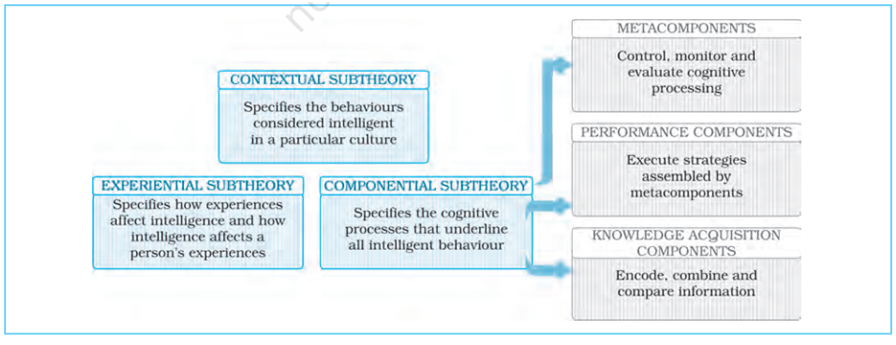
C. PASS Model of Intelligence (by J.P. Das, Jack Naghieri and Kirby)
According to this model, intellectual activity involves the interdependent functioning of three neurological systems, called the functional units of brain. These units are responsible for the following:
i. Arousal / Attention
- State of arousal is basic to any behaviour as it helps us in attending to stimuli.
- Arousal and attention enable a person to process information.
- An optimum level of arousal focuses our attention to the relevant aspects of a problem.
- Too much or too little arousal would interfere with attention.
ii. Simultaneous and Successive Processing
Information can be integrated into your knowledge system either:
a. Simultaneously
Simultaneous processing takes place when you perceive the relations among various concepts and integrate them into a meaningful pattern for comprehension. Example - Raven's Progressive Matrices Test - It helps us in grasping the meaning and relationship between the given abstract figures.
b. Successively
Successive processing takes place when we remember all the information serially so that the recall of one leads to the recall of another.
Example - Learning of digits, alphabets, multiplication tables
iii. Planning (essential feature of intelligence)
- Planning is activated, after the information is attended to and processed.
- allows us to think of the possible courses of action, implement them to reach a target, and evaluate their effectiveness.
These processes (Arousal/Attention, Simultaneous and Successive Processing and Planning) are interactive and dynamic.
Cognitive Assessment System (by Das and Naglieri)
- battery of tests
- consists of verbal as well as non-verbal tasks
- measure cognitive functions
- independent of schooling
- between 5 to 18 yrs of age
- results can be used to remedy cognitive deficits of children with learning problems.
Intelligence: Interplay of Nature and Nurture
- Books Name
- Psychology Book Class-12
- Publication
- PathSet Publications
- Course
- CBSE Class 12
- Subject
- Psychology
Intelligence: Interplay of Nature and Nurture/ Product of complex interaction of Nature and Nurture
Correlation of intelligence:
- Identical twins reared together - 0.90
- Identical twins reared in different environments - 0.72
- Fraternal twins reared together - 0.60
- Siblings reared together - 0.50
- Siblings reared apart - 0.25
- Children's intelligence is more similar to their biological rather than adoptive parents. However, as children grow in age, their intelligence level tends to move closer to that of their adoptive parents.
- Environmental deprivation lowers intelligence while rich nutrition, good family background and quality of schooling increases intelligence.
- Heredity is something that sets a range within which an individual's development is actually shaped by the support and opportunities of the environment.
Assessment of Intelligence
- Books Name
- Psychology Book Class-12
- Publication
- PathSet Publications
- Course
- CBSE Class 12
- Subject
- Psychology
Assessment of Intelligence
- 1905 - Alfred Binet and Theodore Simon - first attempt to formally measure intelligence (Binet-Simon Scale)
- Mental Age (MA) is a measure of a person's intellectual development relative to people of her/his age group.
- Chronological Age (CA) is the biological age from birth.
- Retardation was defined as being two mental age years below the chronological age.
- IQ = MA/CA x 100 (by William Stern in 1912)
Intelligence Quotient (IQ) refers to mental age divided by chronological age multiplied by 100. The number 100 is used as a multiplier to avoid the decimal point.
MA = CA, IQ = 100
MA > CA, IQ > 100
MA < CA, IQ < 100
- For example, a 10-year-old child with a mental age of 12 would have an IQ of 120 (12/10 x 100), whereas the same child with an MA of 7 would have an IQ of 70 (7/10 x 100).
- The scores of most people tend to fall in the middle range of the distribution. Only a few people have either very high or very low scores.
- The frequency distribution for the IQ scores tends to approximate a bell-shaped curve, called the normal curve. This type of distribution is symmetrical around the central value, called the mean.
- Mean IQ score in a population is 100.
- People with IQ scores in the range of 90–110 have normal intelligence.
- Those with IQ below 70 are suspected to have ‘intellectual disability’, while persons with IQ above 130 are considered to have exceptional talents.
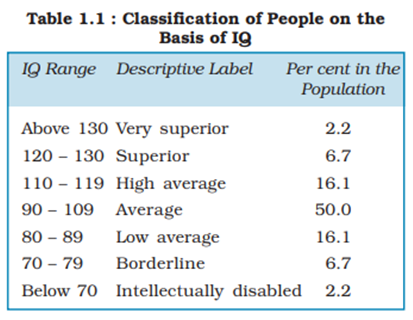
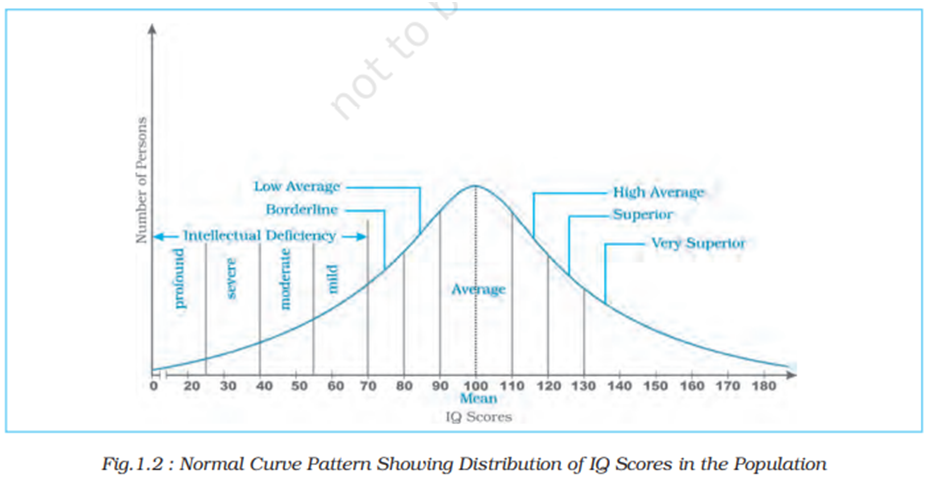
Variations of Intelligence
- Books Name
- Psychology Book Class-12
- Publication
- PathSet Publications
- Course
- CBSE Class 12
- Subject
- Psychology
Variations of Intelligence
Intellectual Deficiency
- Children face enormous difficulty in learning even very simple skills
- These children who show intellectual deficiency are 'intellectually disabled'
- The American Association on Mental Deficiency (AAMD) views intellectual disability as "significantly sub-average general intellectual functioning existing concurrently with deficits in adaptive behaviour and manifested during the developmental age."
Three features of the above definition are:
- 'significantly sub-average intellectual functioning' is a must to be regarded as intellectually disabled having IQ below 70.
- 'deficits in adaptive behaviour' where, adaptive behaviour means a person's capacity to be independent and deal effectively with one's environment.
- deficits must be observed during the 'developmental period' i.e. between 0 and 18yrs of age.
- Taught to work and function with special attention
- Some cannot be trained and require institutional care throughout their lives
- Different levels of intellectually disability:
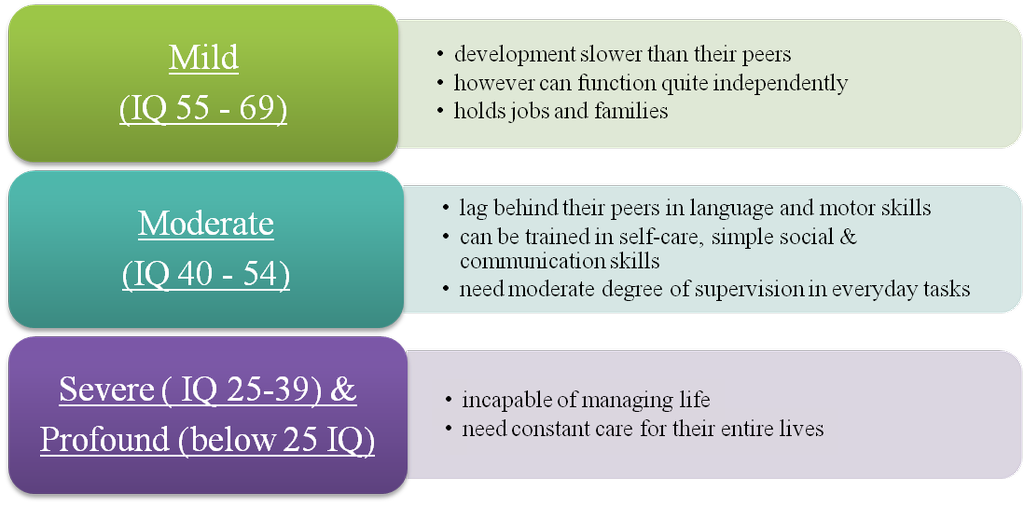
Intellectual Giftedness
- Higher performance because of their outstanding potentialities.
- Giftedness is exceptional general ability shown in superior performance in a wide variety of areas
- Talent refers to remarkable ability in a specific field. The highly talented are sometimes called 'prodigies'.
- Giftedness depends on a combination of high ability, high creativity, and high commitment, from teachers’ point of view.
- Gifted children show early signs of intellectual superiority. Even during infancy and early childhood, they show:
- larger attention span
- good recognition memory
- preference for novelty
- sensitivity to environmental changes
- early appearance of language skills
Characteristics of gifted children are:
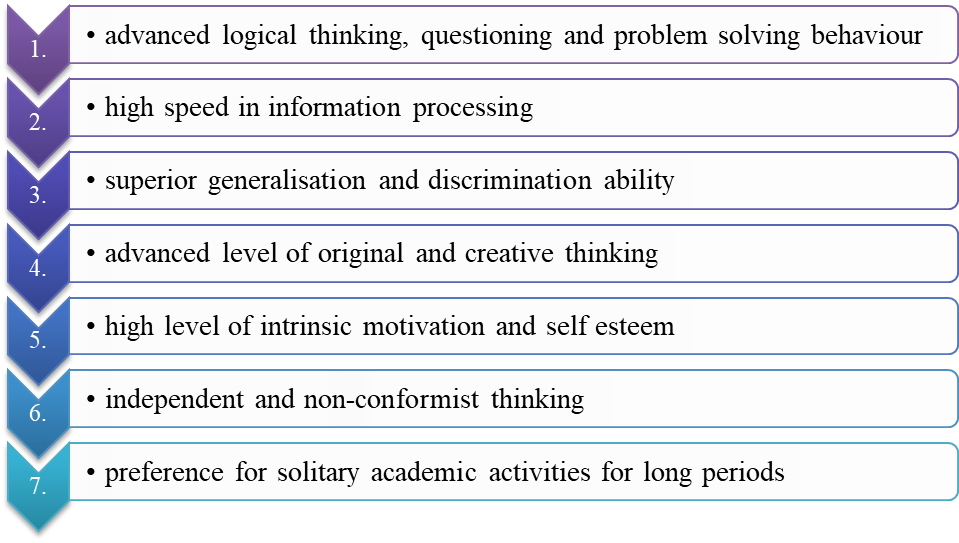
Types of Intelligence Tests
- Books Name
- Psychology Book Class-12
- Publication
- PathSet Publications
- Course
- CBSE Class 12
- Subject
- Psychology
Types of Intelligence Tests
Individual or Group Tests
- Individual Tests
- Individual tests are administered to one person at a time.
- These tests require the test administrator to establish a rapport with the subject and be sensitive to her/his feelings, moods expressions during the testing session.
- These allow people to answer orally in a written form or manipulate objects as per the tester's instructions.
Group Tests
- A group intelligence test can be administered to several persons simultaneously.
- These do not allow an opportunity to be familiar with the subjects' feelings.
- They seek written answers usually in a MCQ format.
Verbal, Non-verbal or Performance Tests
Verbal Tests
- These tests require subjects to give verbal responses either orally or in written form.
- These tests can be administered only to literate people.
Non-Verbal Tests
- The non-verbal tests use pictures or illustrations as test items. These can be administered on illiterate people as well.
- Example- Raven's Progressive Matrices (RPM) Test
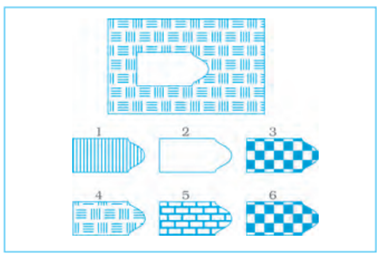
Performance Tests
- Performance tests require subjects to manipulate objects and other materials to perform a task.
- Written language is not necessary for answering the items.
- They can be easily administered to people from different cultures.
- Example- Kohs' Block Design Test
Culture-Fair or Culture-Biased Tests
Culture-Fair Tests
- Culture-fair or culturally appropriate tests are those that do not discriminate against individuals belonging to different cultures.
- These tests are developed in a manner that they assess experiences common to all cultures or have questions in which language usage is not required.
- Non-verbal and performance tests help reduce the cultural bias usually associated with verbal tests.
Culture-Biased Tests
- Culture-biased tests are designed for a specific population and show biased results for a specific group, culture, and population due to cultural influence.
Misuses of Intelligence Tests
- Poor performance on a test may make the child ashamed and thereby adversely affect their performance and self-respect.
- The results of the test may invite discriminatory practices / treatment from parents, teachers and elders in the society.
- Intelligence tests do not capture creative potentialities and practical side of intelligence.
- They do not relate much to success in life.
- Administering a test biased in favour of high class and middle class populations may underestimate the IQ of children coming from disadvantaged sections of the society.
Intelligence Testing in India
- Books Name
- Psychology Book Class-12
- Publication
- PathSet Publications
- Course
- CBSE Class 12
- Subject
- Psychology
Intelligence Testing in India
- S.M. Mohsin made a pioneering attempt in constructing an intelligence test in Hindi in the 1930s.
- C.H. Rice attempted to standardise Binet’s test in Urdu and Punjabi.
- At about the same time, Mahalanobis attempted to standardise Binet’s test in Bengali.
- Attempts were also made by Indian researchers to develop Indian norms for some western tests including RPM, WAIS, Alexander’s Passalong, Cube Construction, and Kohs’ Block Design.
- Long and Mehta prepared a Mental Measurement Handbook listing out 103 tests of intelligence in India that were available in various languages.
- Since then, a number of tests have either been developed or adapted from western cultures.
- The National Library of Educational and Psychological Tests (NLEPT) at the National Council of Educational Research and Training (NCERT) has documented Indian tests. Critical reviews of Indian tests are published in the form of handbooks. NLEPT has brought out the handbooks in the area of intelligence, aptitude, personality, attitudes, and interests.
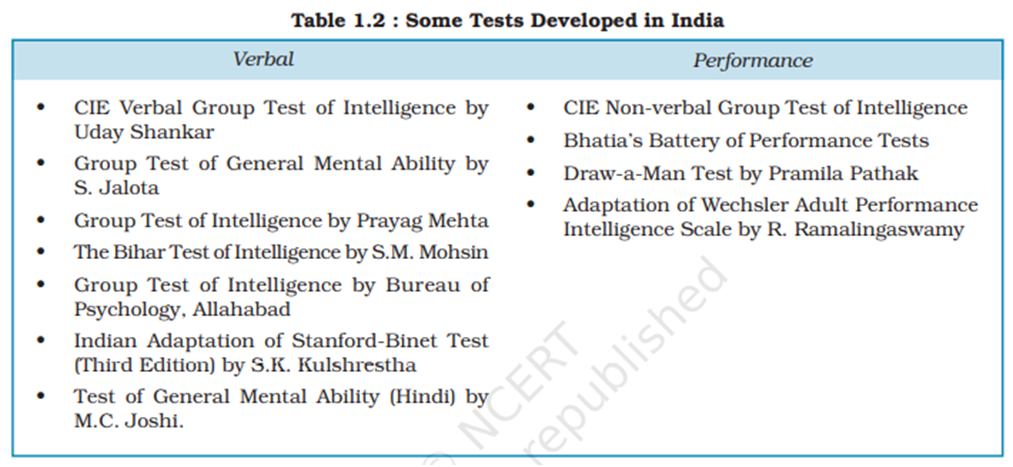
Culture and Intelligence
- Books Name
- Psychology Book Class-12
- Publication
- PathSet Publications
- Course
- CBSE Class 12
- Subject
- Psychology
Culture and Intelligence
- Culture is a collective system of customs, beliefs, attitudes and achievements in art and literature.
- The cultural environment provides a context for intelligence to develop.
- Vygotsky, a Russian psychologist, has argued that culture provides a social context in which people live, grow and understand the world around them.
For example, in less technologically developed societies, social and emotional skills in relating to people are valued, while in technologically advanced societies, personal achievement founded on abilities of reasoning and judgment is considered to represent intelligence.
- Vygotsky also believed that cultures, like individuals, have a life of their own; they grow and change, and in the process specify what will be the end-product of successful intellectual development.
- According to him, while elementary mental functions (e.g., crying, attending to mother’s voice, sensitivity to smells, walking, and running) are universal, the manner in which higher mental functions such as problem solving and thinking operate are largely culture-produced.
- Sternberg's notion of contextual or practical intelligence implies that intelligence is a product of culture.
Technological Intelligence
- In technologically advanced societies, personal achievement founded on abilities of reasoning and judgement is considered to represent intelligence.
- Focus on individualistic orientation.
- Technologically advanced societies adopt child rearing practices that foster skills of:
- Generalisation and abstraction
- Speed
- Minimal moves
- Mental manipulation, among children.
- In these societies, people are well-versed in skills of:
- Attention
- Observation
- Analysis
- Performance
- Speed
- Achievement orientation
Intelligence tests developed in western cultures look precisely for these skills in an individual.
Intelligence in the Indian Tradition
- Books Name
- Psychology Book Class-12
- Publication
- PathSet Publications
- Course
- CBSE Class 12
- Subject
- Psychology
Integral Intelligence (Intelligence in the Indian tradition)
- Gives emphasis on connectivity with the social and world environment.
- From a holistic perspective, equal attention is paid to cognitive and non cognitive processes as well as their integration as a part of intelligence.
- Focus on collectivistic orientation
- Value self-reflection
- Less technologically developed societies value social and emotional skills in relating to people
- Buddhi, according to J.P. Das includes such skills as:
- Mental effort
- Determined action
- Feelings
- Opinions,
along with cognitive competence such as:
- Knowledge
- Discrimination
- Understanding
Buddhi is the knowledge of one's own self based on conscience, will and desire.
Buddhi has affective and motivational components besides a strong cognitive component.
- Facets of Intelligence in the Indian tradition :
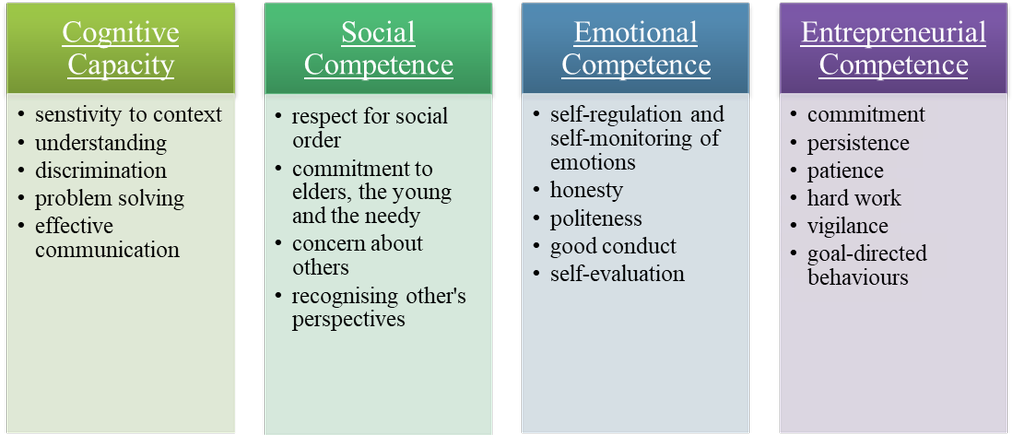
Emotional Intelligence
- Books Name
- Psychology Book Class-12
- Publication
- PathSet Publications
- Course
- CBSE Class 12
- Subject
- Psychology
Emotional Intelligence
- Considers that intelligence includes emotions.
- Emotional intelligence is a set of skills that underlie accurate appraisal, expression, and regulation of emotions.
- It is the feeling side of intelligence.
- Salovey and Mayer defined emotional intelligence as " the ability to monitor one's own and other's emotions, to discriminate among them, and to use the information to guide one's thinking and actions."
- Emotional Quotient (EQ) is used to express emotional intelligence in the same way as IQ is used to express intelligence.
- Emotional intelligence refers to the ability to process emotional information accurately and efficiently.
- Applications of Emotional Intelligence:
- Emotional intelligence is receiving increasing attention of educators for dealing with students who are affected by stresses and challenges of the outside world.
- Programmes aimed at improving students’ emotional intelligence have beneficial effects on their academic achievement.
- They encourage cooperative behaviour and reduce their antisocial activities.
- These programmes are very useful in preparing students to face the challenges of life outside the classroom.
Characteristics of Emotionally Intelligent People are:
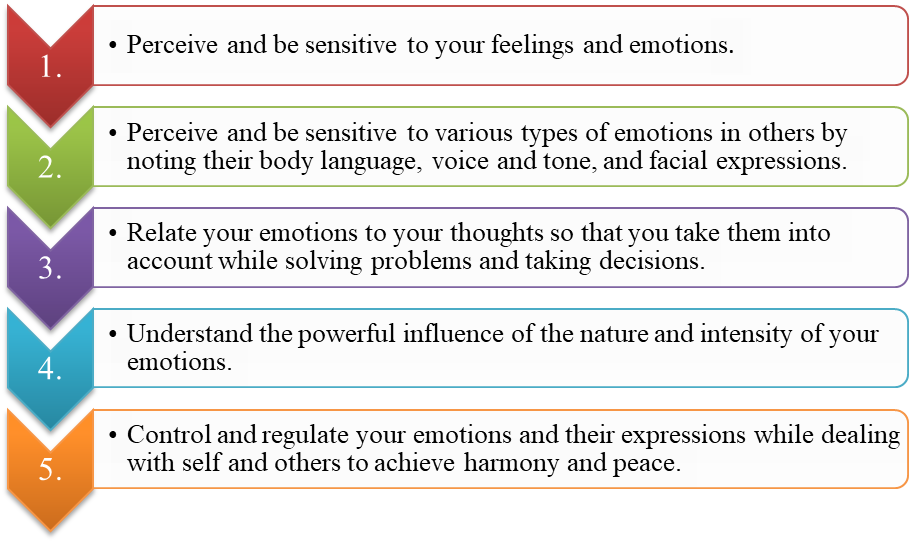
Aptitude : Nature and Measurement
- Books Name
- Psychology Book Class-12
- Publication
- PathSet Publications
- Course
- CBSE Class 12
- Subject
- Psychology
Aptitude and Intelligence
- People with similar intelligence differed widely in acquiring certain knowledge or skills.
- Therefore, individuals with similar level of intelligence may have different aptitudes. For example, two students who have more or less the same level of intelligence, one may have a high verbal reasoning aptitude whereas the other student may have high numerical reasoning aptitude and low verbal reasoning aptitude.
Aptitude and Interest
- A person may be interested in a particular job or activity, but may not have the aptitude for it. Similarly, a person may have the potentiality for performing a job, but may not be interested in doing that. In both cases, the outcome will not be satisfactory.
- For example, a student with high mechanical aptitude and strong interest in engineering is more likely to be a successful mechanical engineer.
- Therefore, in order to be successful in a particular field, a person must have both aptitude and interest.
Aptitude tests are available in two forms:
- Independent (specialised) Aptitude Tests
Examples: Clerical Aptitude, Mechanical Aptitude, Numerical Aptitude, and Typing Aptitude
- Multiple (generalised) Aptitude Tests
Multiple Aptitude Tests exist in the form of test batteries, which measure aptitude in several separate but homogeneous areas.
Examples: Differential Aptitude Tests (DAT), the General Aptitude Tests Battery (GATB), and the Armed Services Vocational Aptitude Battery (ASVAB) are well-known aptitude test batteries.
Among these, DAT is most commonly used in educational settings. It consists of 8 independent subtests: (i) Verbal Reasoning, (ii) Numerical Reasoning, (iii) Abstract Reasoning, (iv) Clerical Speed and Accuracy, (v) Mechanical Reasoning, (vi) Space Relations, (vii) Spelling, and (viii) Language Usage.
J.M. Ojha has developed an Indian adaptation of DAT.
Several other aptitude tests have been developed in India for measuring scientific, scholastic, literary, clerical, and teaching aptitudes.
Creativity and Intelligence
- Books Name
- Psychology Book Class-12
- Publication
- PathSet Publications
- Course
- CBSE Class 12
- Subject
- Psychology
Creativity
- Creativity is the ability to produce ideas, objects, or problem solutions that are novel, appropriate and useful.
- Manifestations of creativity can be observed in:
- a novel solution to a problem
- an invention
- composition of a poem or a painting
- new chemical process
- an innovation in law
- a breakthrough in preventing a disease, etc
- One common element among these is the production of something new and unique.
- Creativity is not just limited to a selected few — the artist, the scientist, the poet or the inventor. An ordinary individual who is engaged in simple occupations like pottery, carpentry, cooking, etc. can also be creative.
- Individuals vary in terms of the level and the areas in which they exhibit creativity and that all may not be operating at the same level.
- Another level of creativity is working on what has already been established earlier by way of modifications, by putting things in new perspectives or to new use.
- Children express creativity mostly through physical activities and in non-verbal ways.
- Creativity is determined by both heredity and environment. Limits of the creative potential are set by heredity, and environmental factors (such as motivation, commitment, family support, peer influences, training opportunities, etc.) stimulate the development of creativity.
Creativity and Intelligence
- Terman, in the 1920s, found that:
- persons with high IQ were not necessarily creative
- creative ideas could come from persons who did not have a very high IQ
- Both high and low level of creativity can be found in highly intelligent children and also children of average intelligence.
- The same person, thus, can be creative as well as intelligent but it is not necessary that intelligent ones, in the conventional sense, must be creative.
Intelligence, therefore, by itself does not ensure creativity.
- However, it has been found that the relationship between creativity and intelligence is positive.
- All creative acts require some minimum ability to acquire knowledge and capacity to comprehend, retain, and retrieve.
- Hence, a certain level of intelligence is required for creativity but beyond that intelligence does not correlate well with creativity.
Features of Creativity Tests
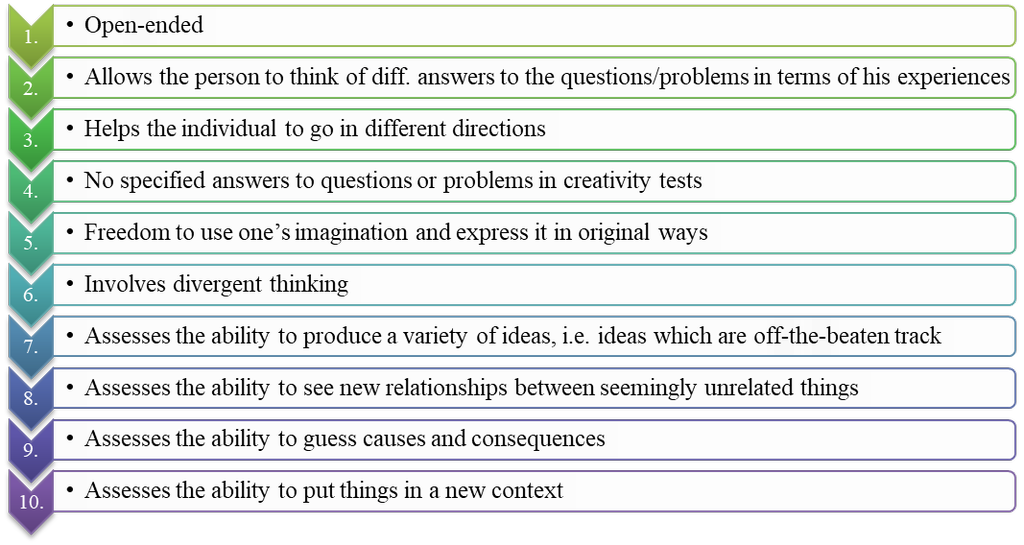
Some of the famous psychologists who have developed creativity tests are:
- Guilford
- Torrance
- Khatena
- Wallach and Kogan
- Paramesh
Features of Intelligence Tests
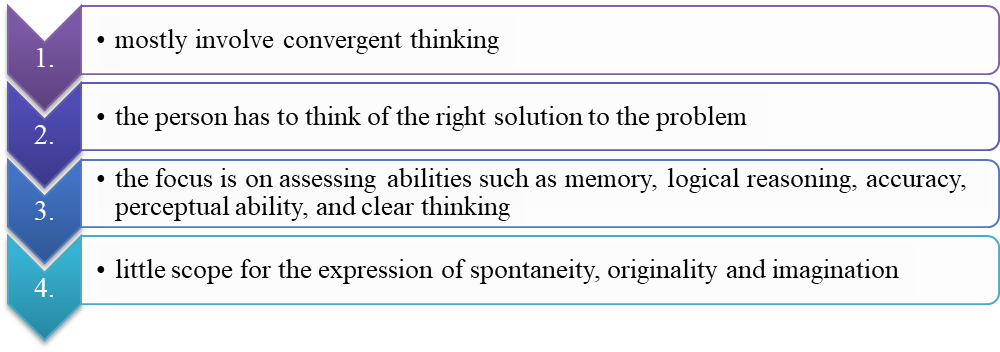

 PathSet Publications
PathSet Publications
